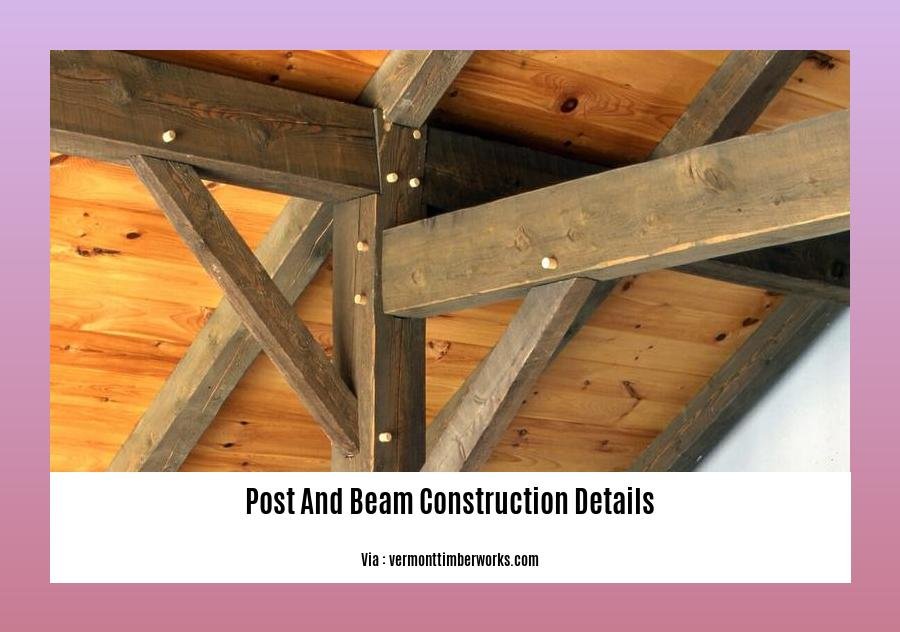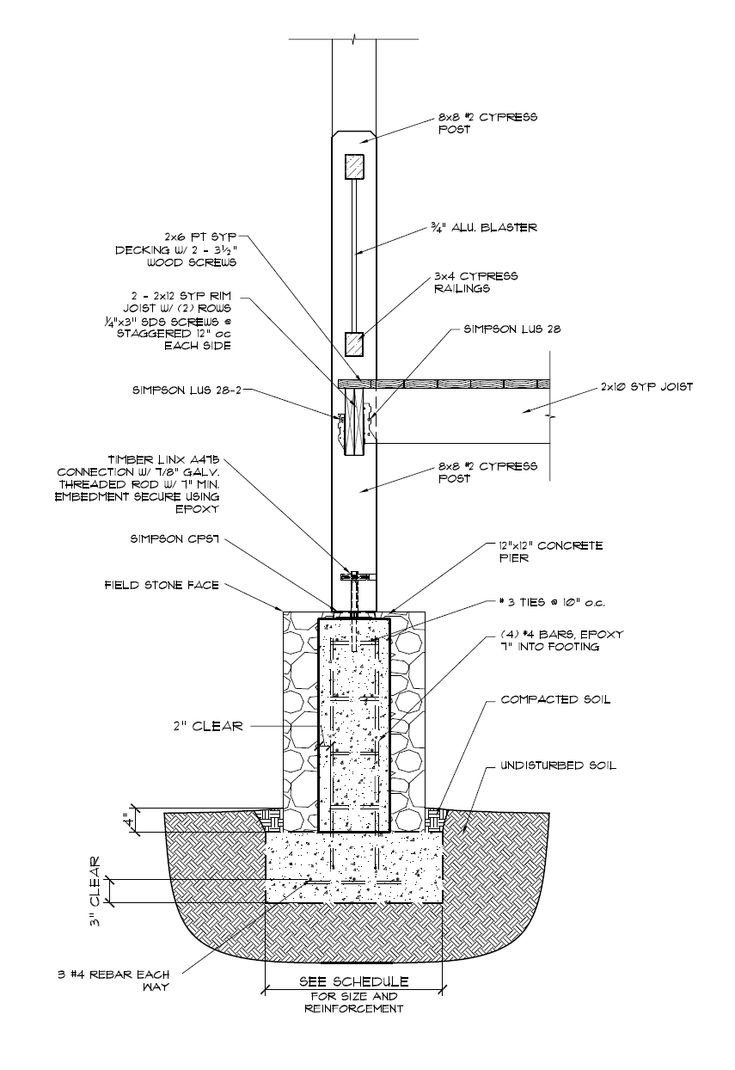Embark on a comprehensive journey through post and beam construction with our definitive guide. Discover the intricate details and principles behind this enduring technique, from its aesthetic charm to its unwavering structural integrity. Unearth the secrets of post and beam joinery, load-bearing dynamics, and the art of material selection. Prepare to elevate your construction knowledge and embrace the legacy of post and beam craftsmanship.
Key Takeaways:
- Post and beam construction involves horizontal beams transferring loads to vertical posts.
- Diagonal braces enhance structural stability.
- Foundation, piers, post-anchors, slabs, and beam-to-post connections are vital structural elements.
- Post and beam construction stands out visually from other construction methods.
Post and Beam Construction Details
Post and beam construction is an architectural approach that employs load-bearing vertical members called posts and horizontal weight-distributing elements called beams. These components combine to create a durable structure with distinctive aesthetic appeal.
Structural Elements of a Post and Beam System
- Foundation: The base of the structure, typically made of concrete or masonry.
- Piers: Concrete supports that transfer the weight of the posts to the foundation.
- Posts: Vertical timbers that support the beams.
- Beams: Horizontal members that carry the weight of the roof and upper floors.
- Beam-to-Post Connections: Joints that connect the beams to the posts, allowing for load transfer and structural stability.
Advantages of Post and Beam Construction
- Durability: Post and beam structures are exceptionally strong and resilient due to the use of sturdy timber components.
- Flexibility: This method allows for open floor plans and extensive window installations, providing ample natural light.
- Aesthetics: The exposed timbers create a visually striking interior and exterior, adding character to any space.
- Energy Efficiency: Post and beam homes can be designed to reduce heat loss, resulting in energy savings.
Building with Post and Beam
- Choose the right wood: Opt for durable species like oak, cedar, or pine for posts and beams.
- Design the beam-to-post connections: Ensure secure connections using mortise-and-tenon joints, metal brackets, or structural screws.
- Incorporate diagonal bracing: Add diagonal braces to enhance the structure’s stability and resistance to lateral forces.
- Treat the wood properly: Protect the timber from moisture and insects using appropriate sealants and finishes.
Post and beam construction offers a timeless aesthetic, unmatched structural integrity, and flexibility in design. By understanding its details and employing proper building techniques, you can create a durable and stunning home that will stand the test of time.
Wondering what kind of exercises will help you recover after an ACL reconstruction? Want to know how post and beam construction kits can simplify your building process? Looking for proven techniques to master post and beam construction? Eager to get your hands on a comprehensive post-construction clean-up checklist? Curious about the costs involved in post-construction clean-up? Click on the links below to access valuable information.
- Learn about post-ACL reconstruction exercises that can aid in your recovery.
- Explore the benefits of using post and beam construction kits for your next project.
- Discover effective post and beam construction techniques to elevate your building skills.
- Utilize our post-construction clean-up checklist to ensure a spotless finish.
- Find out the post-construction clean-up cost to budget effectively for your project.
Understanding Post and Beam Joinery Techniques
You’ve got a dream of a sturdy yet elegant home, and Understanding Post and Beam Joinery Techniques is your gateway to making it a reality. Let’s dive right into the heart of this timeless construction method.
Deciphering the Anatomy of a Joint
Imagine a post, a vertical pillar, and a beam, a horizontal beam. Their union creates a joint, the backbone of your post and beam structure. There are two main types of joints:
- Mortise and Tenon Joint: The post has a slot (mortise) where the beam’s protruding end (tenon) fits snugly. Picture a puzzle piece fitting into place.
- Lap Joint: The post and beam overlap, creating a simple and straightforward connection. It’s like two pieces of wood giving each other a hug.
Choosing the Right Wood
Selecting the right wood for your joints is crucial. Oak, hickory, and pine are favorites for their strength and durability. These woods can withstand the weight of your structure and resist rot.
Crafting the Perfect Joint
- Measure and Mark: Determine the exact points where the joint will be made. Use a ruler and pencil for precise measurements.
- Create the Mortise: Using a chisel and mallet, carve out the mortise in the post. Ensure the dimensions match the tenon’s size.
- Cut the Tenon: Use a saw to cut the tenon’s end on the beam. The tenon should fit snugly into the mortise.
- Assemble the Joint: Apply wood glue to the mortise and tenon, then slide them together. Use a mallet to gently tap the joint into place.
- Secure the Joint: Reinforce the joint with nails or screws. This adds extra strength and stability.
Key Takeaways:
- Understand the types of joints used in post and beam construction: mortise and tenon, lap joint.
- Choose the right wood for your joints based on strength and durability.
- Follow the proper steps to craft a strong and durable joint.
- Secure the joint with nails or screws for added strength.
Sources:
- Understanding Post and Beam Joinery Techniques
- Post and Beam Joiners: A Comprehensive Guide
Load-Bearing Principles in Post and Beam Structures

As we journey into the realm of post and beam construction, let’s unravel the secrets of how these structures stand tall and resilient. Understanding the load-bearing principles is crucial for ensuring the integrity and safety of your post and beam abode.
How do post and beam structures bear loads?
The secret lies in the ingenious interplay between the vertical posts and horizontal beams. Posts, like sturdy pillars, transfer the weight of the roof, walls, and other elements to the ground. These posts are carefully placed to distribute the load evenly, preventing them from buckling under pressure.
Beams, on the other hand, serve as the backbone of the structure. They run parallel to each other, supported by the posts. The weight of the roof and other loads is effectively transferred along the beams, creating a strong and balanced framework.
KeyTakeaways:
- Posts transfer weight vertically to the ground.
-Beams distribute the load horizontally, creating a stable structure. -
Proper placement of posts and beams ensures even load distribution.
-
Types of load-bearing systems in post and beam construction:
-
Continuous beam system: The most common type, where beams run continuously from one end of the structure to the other.
- Cantilevered beam system: Used to create overhanging structures, where beams extend beyond the supporting posts.
- Rigid frame system: Combines beams and posts into a triangular or rectangular framework for added stability.
Factors that affect load-bearing capacity:
- Material selection: The type of wood used for posts and beams plays a crucial role in determining the load-bearing capacity.
- Design: The size and spacing of posts and beams must be carefully calculated to ensure they can withstand the anticipated loads.
- Connections: The strength of the connections between posts and beams is essential for maintaining the overall load-bearing capacity.
Understanding load-bearing principles is paramount in post and beam construction. By carefully considering these factors, you can create structures that endure the weight of time and the elements, standing as testaments to architectural prowess and resilience.
Sources:
- Post and Beam Construction (Design & Building Guide)
- Understanding Load-Bearing Structures
Post and Beam Construction for Sustainable and Energy-Efficient Homes
Key Takeaways:
- Sustainability: Post and beam construction uses natural materials, reducing environmental impact.
- Energy Efficiency: The open design and exposed beams promote natural ventilation and reduce heat loss.
- Durability: Heavy timbers provide exceptional strength and longevity.
- Flexibility: Open floor plans allow for adaptability and future expansion.
- Aesthetics: Exposed beams create a warm and inviting atmosphere.
Overview
Post and Beam Construction for Sustainable and Energy-Efficient Homes involves constructing homes using heavy timbers called beams and posts. This construction method combines traditional aesthetics with modern energy efficiency.
Sustainability:
Post and beam structures primarily use natural materials like timber, which is a renewable resource. By reducing the use of processed materials, this construction method minimizes environmental impact.
Energy Efficiency:
The open design of post and beam homes allows for increased natural ventilation, reducing the need for artificial cooling. Exposed beams and posts minimize heat loss, improving overall thermal performance.
Durability:
Heavy timbers provide exceptional structural integrity, ensuring the longevity of the home. Post and beam structures are resistant to rot, decay, and insect infestation with proper treatment.
Flexibility:
Open floor plans and minimal load-bearing walls offer flexibility in design. Homeowners can easily reconfigure spaces and make additions as their needs evolve.
Aesthetics:
Exposed beams and posts create a visually striking interior. The natural warmth and texture of timber enhance the overall ambiance of the home.
FAQs:
Q: How does post and beam construction differ from traditional framing methods?
A: Post and beam construction relies heavily on exposed timbers for structural support, while traditional framing methods often use load-bearing walls.
Q: Is post and beam construction more expensive than traditional methods?
A: Yes, post and beam construction typically requires more materials and specialized labor, resulting in higher construction costs.
Conclusion
Post and beam construction offers a sustainable, energy-efficient, and aesthetically pleasing approach to home building. Its durability, flexibility, and natural charm make it a compelling choice for homeowners seeking a unique and environmentally conscious living space.
Citations:
- Green Building Elements: Post and Beam Construction
- Yankee Barn Homes: 5 Things to Know When Building a Post and Beam Home
FAQ
Q1: What is the most important aspect to consider when building a post and beam structure?
A1: Ensuring proper load distribution and structural integrity by considering the weight of the structure and the strength of the materials used.
Q2: Can post and beam construction be used for both residential and commercial buildings?
A2: Yes, post and beam construction is suitable for a wide range of structures, including homes, offices, and industrial buildings.
Q3: What are the advantages of using steel posts and beams in post and beam construction?
A3: Steel provides higher strength, fire resistance, and termite resistance compared to traditional timber posts and beams, making it more durable and low-maintenance.
Q4: How can I achieve a more modern look with post and beam construction?
A4: Utilizing glass panels, incorporating linear details, and choosing contemporary finishes for the posts and beams can enhance the aesthetics and create a modern appearance.
Q5: Are there any energy-efficient features that can be incorporated into post and beam construction?
A5: Yes, post and beam structures can incorporate features such as insulated panels, high-performance windows, and strategically placed overhangs to minimize energy consumption and improve thermal performance.
- Dora the Explorer Wipe-Off Fun: Safe & Mess-Free Activities for Little Explorers - April 18, 2025
- Does Lemongrass Repel Mosquitoes? Fact vs. Fiction + How to Use It - April 18, 2025
- Do Woodchucks Climb Trees?Fact vs. Fiction - April 18, 2025










